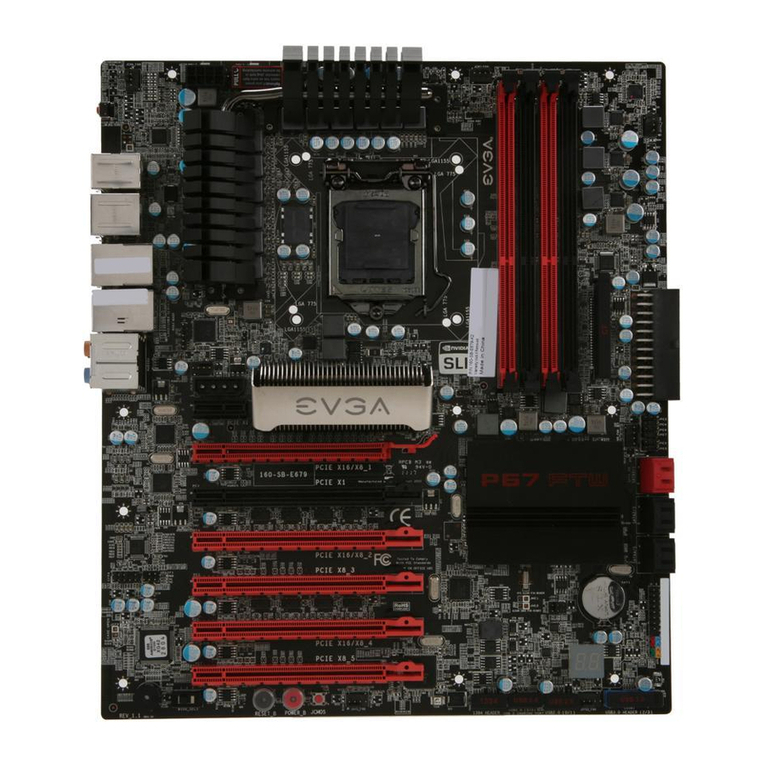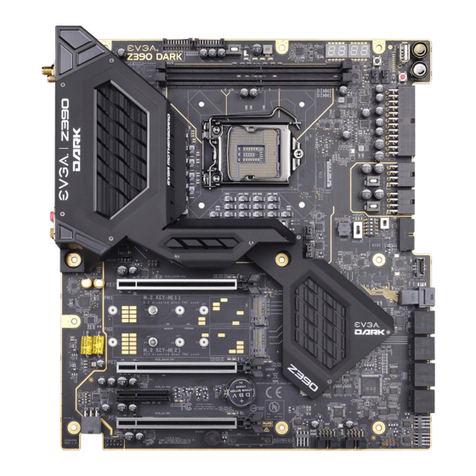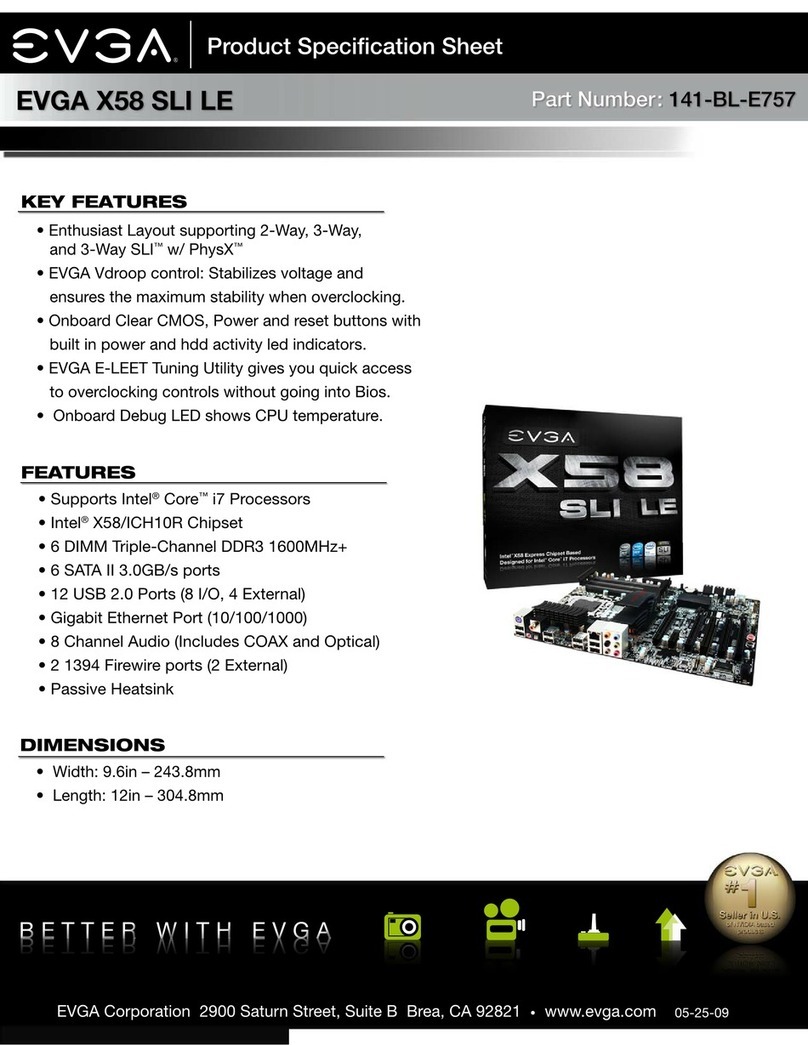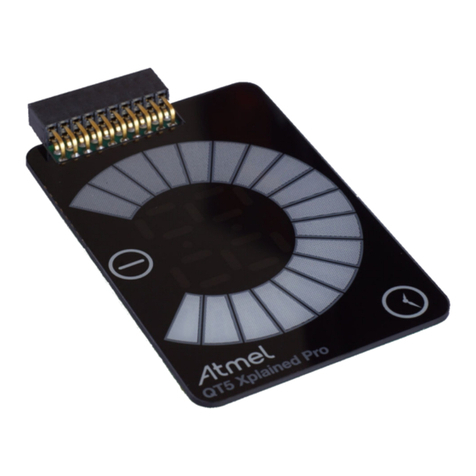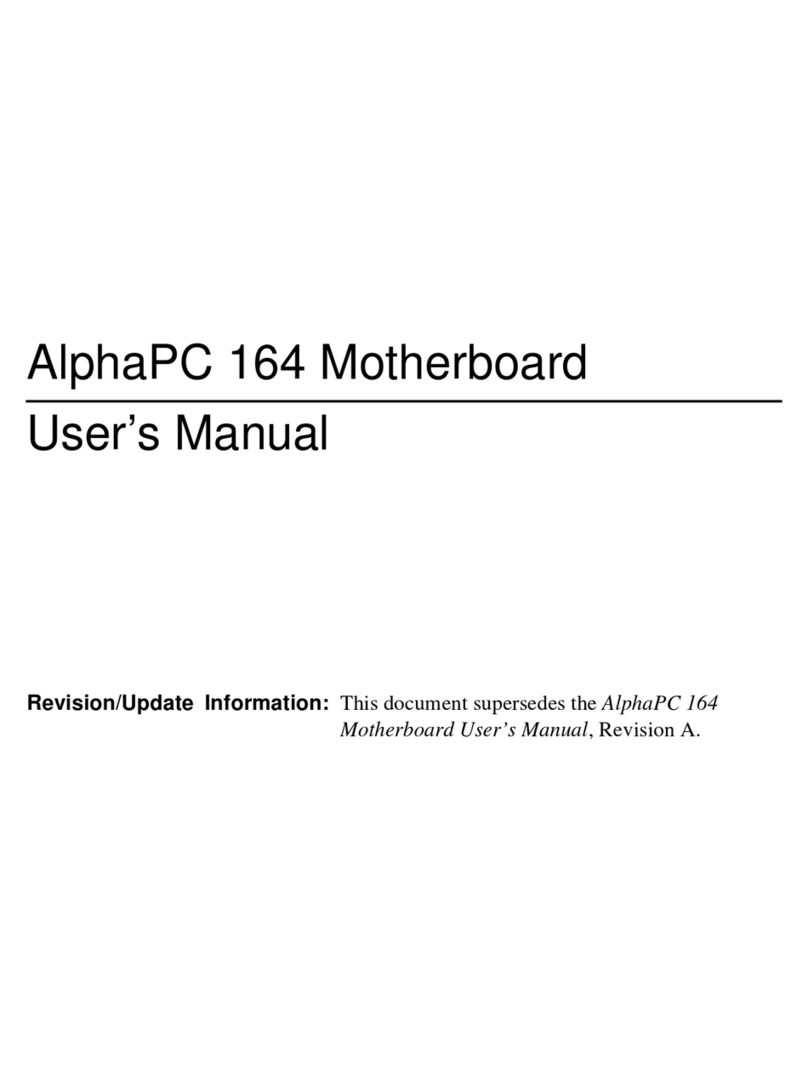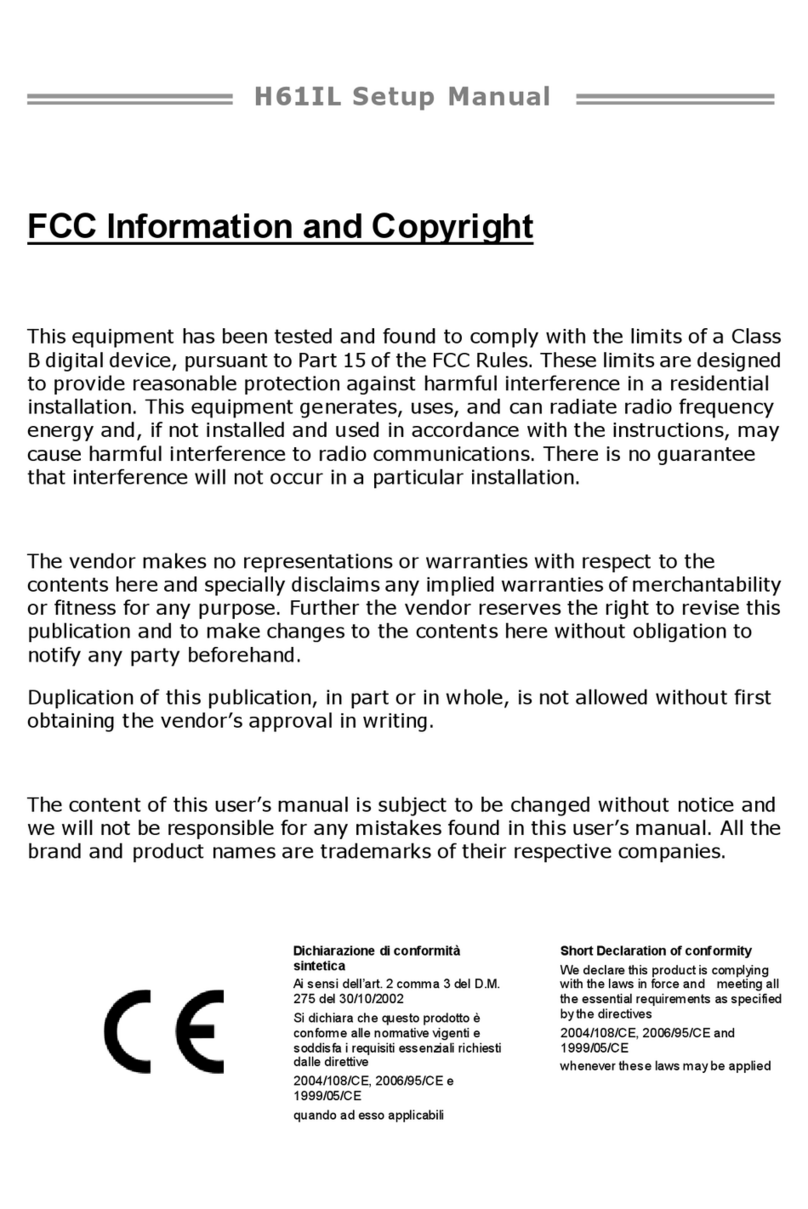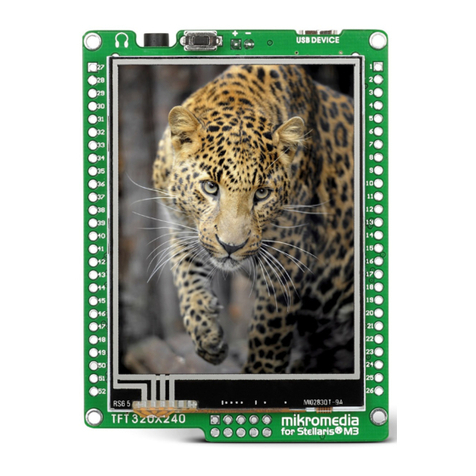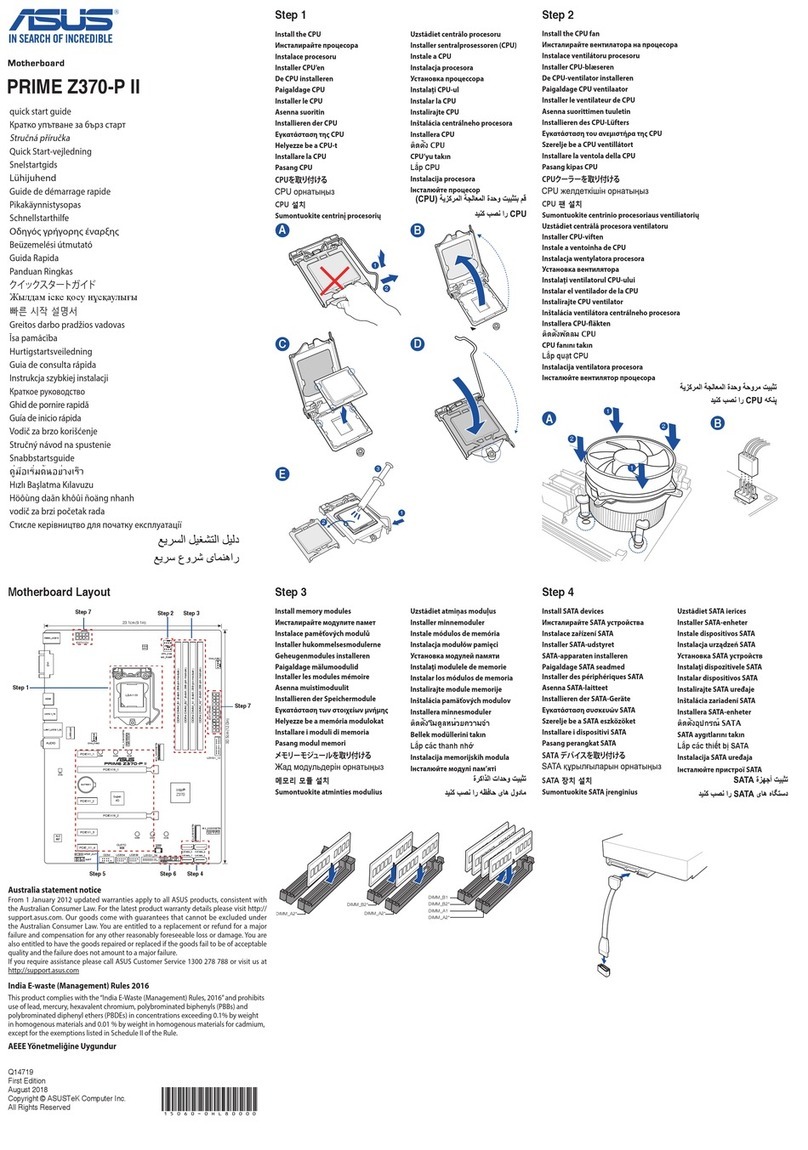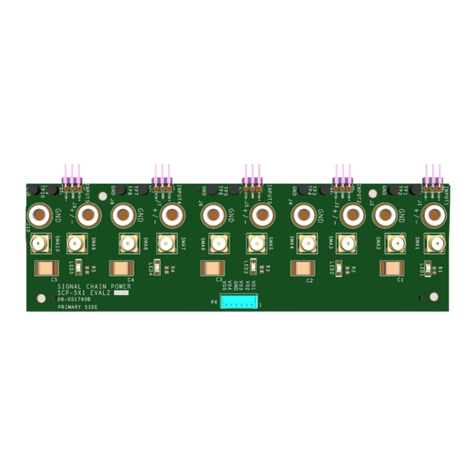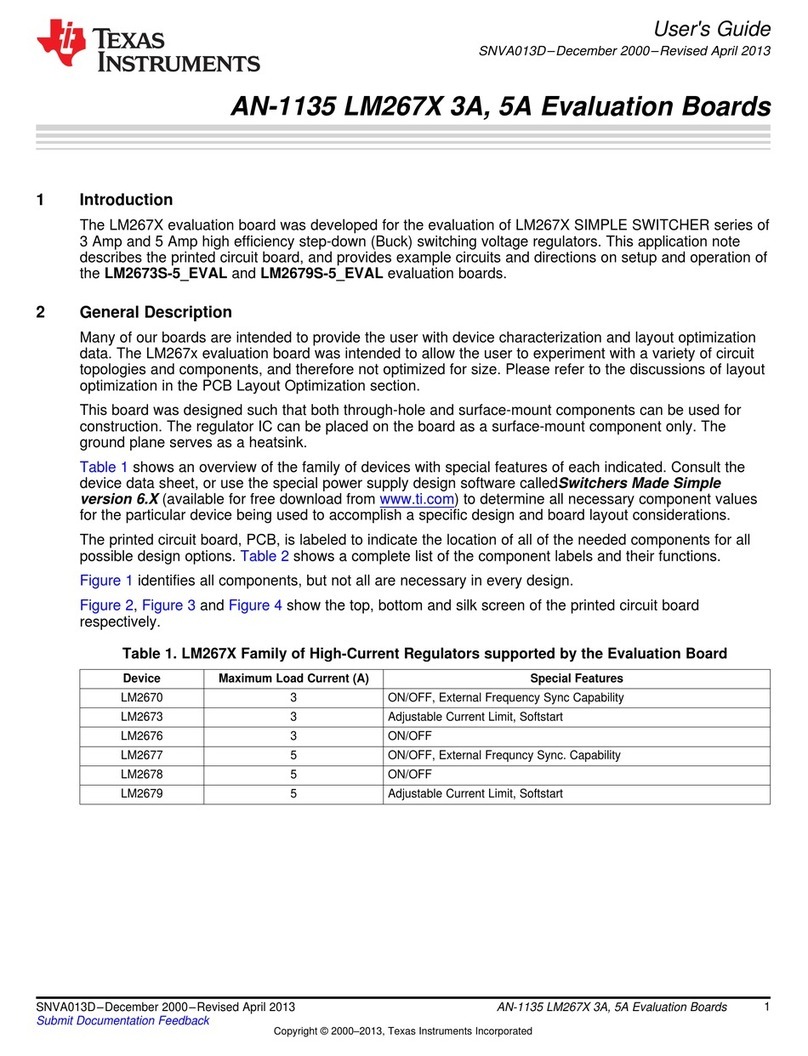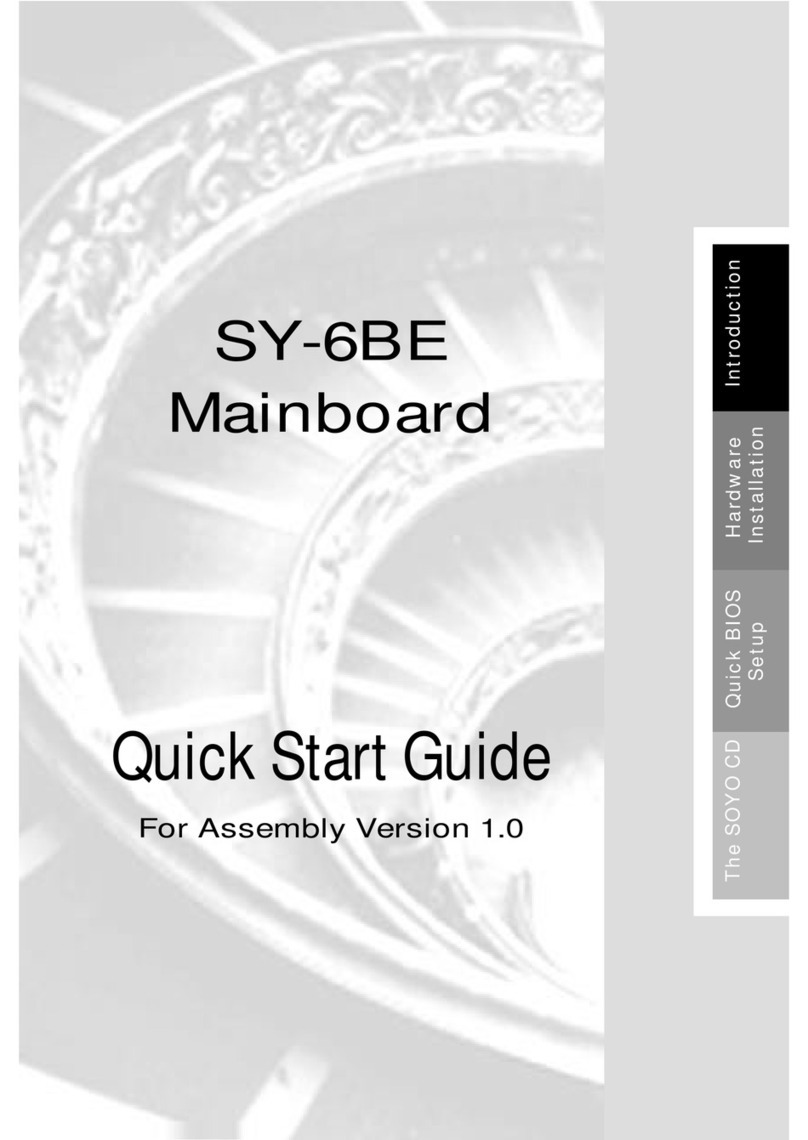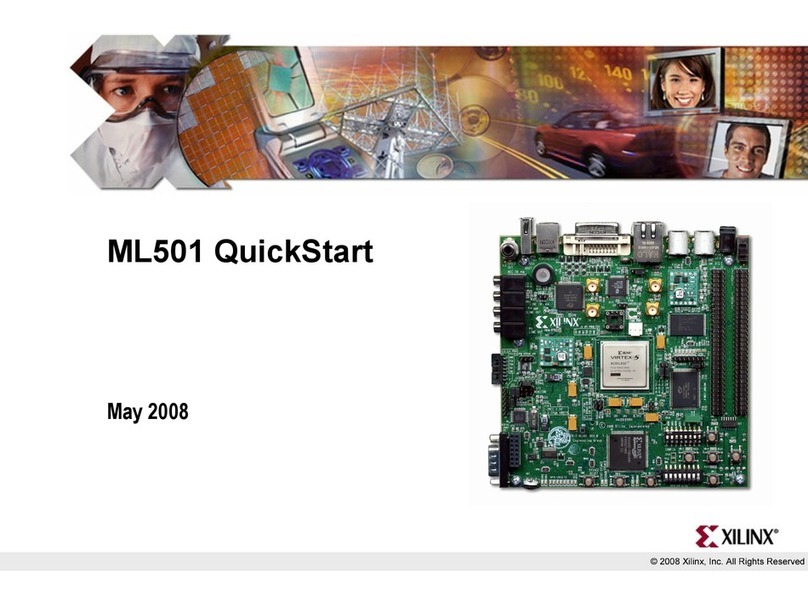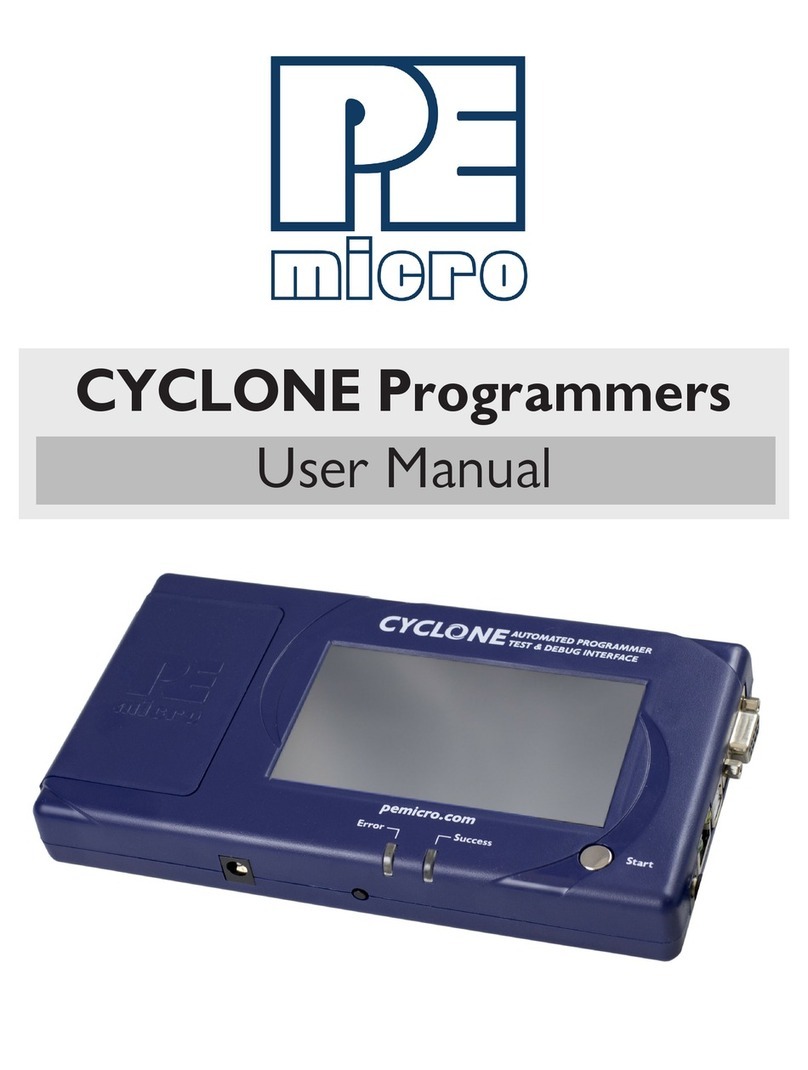EVGA 133K8NF41AX User manual


EVGA.com Corporation 2900 Saturn St. Suite B, Brea, CA 92821
Phone: 888 / 881-EVGA - 714 / 528-4500 - Fax: 714 / 528-4501
Page 1
USER’S MANUAL
FOR
EVGA NFORCE4
MOTHERBOARD
MODELS: 133-K8-NF41-XX
133-K8-NF43-XX
133-K8-NF41/43 MANUAL - REV 1.5 - REV DATE 13 JULY 2005

EVGA.com Corporation 2900 Saturn St. Suite B, Brea, CA 92821
Phone: 888 / 881-EVGA - 714 / 528-4500 - Fax: 714 / 528-4501
Page 2
Notice:
Specifications and information contained in this documentation are
furnished for informational use only, and are subject to change at any
time without notice, and should not be construed as a commitment by the
manufacturer.
This manual covers the following motherboards from EVGA CORP.
133-K8-NF41-XX
133-K8-NF43-XX
Feature 133-K8-NF41-XX 133-K8-NF43-XX
SLI X
Diagnostic LED X X
8 Channel Audio X X
SATA RAID X (SATA 150/300) X (SATA 150)
GigaLan Ethernet X X
Dual Channel DDR X X
CPU Voltage Control X X
BIOS Flash Protection X X

EVGA.com Corporation 2900 Saturn St. Suite B, Brea, CA 92821
Phone: 888 / 881-EVGA - 714 / 528-4500 - Fax: 714 / 528-4501
Page 3
TABLE OF CONTENTS
CHAPTER 1 - Introduction to nForce Motherboards 4
1-1 Motherboard Features 4
1-1.1 Special Features of the Motherboard 5
1-2 Specifications 6
1-3 Layout Diagram and Jumper Settings 7
1-3.1 Jumpers, Connectors, Headers, and Sockets 8
CHAPTER 2 - Hardware Installation 10
2-1 Hardware Installation Steps 10
2-2 Checking The Motherboard Jumper Settings 10
Clearing the CMOS RAM 10
Keyboard Power On Function 11
USB Power On Function 11
2-3 Installing The CPU 11
Glossary of Terms 11
2-3-2 About AMD Athlon64 939-pin CPUs 12
2-4 Installing Memory 13
Memory Installation Diagrams 14
2-5 Expansion Cards 15
2-5-1 Procedure For Expansion Card Installation 15
2-5-2 Assigning IRQs For Expansion Cards 15
2-5-3 Interrupt Request Table 16
2-5-4 PCI-Express Slots 16
Diagram of PCI-Express Slot Locations and Functions 16
Table of Standard IRQ Assignments 17
2-5-5 SLI Bridge Installation For NVIDIA SLI Cards (SLI Version Only) 18
2-6 Connectors and Headers 20
2-6-1 Connector Locations 20
2-7 Starting Up Your Computer 28
Beep Code Table 28
CHAPTER 3 - BIOS 29
3-0 Introducting BIOS 29
3-1 Entering BIOS Setup 29
CHAPTER 4 - DRIVER INSTALLATION 30
4-0 Driver Installation 30
4-1 RAID Installation 31
APPENDIX 1 - POST CODES 32
Quick Debug POST Codes 32
Boot Block POST Codes 33
APPENDIX 2 - TRADEMARKS AND NOTICES 34
Copyrights, Trademarks, and Notices 34
FCC Compliance Statement 34
APPENDIX 3 - WARRANTY INFORMATION 35
36APPENDIX 4 - CONTACTING SUPPORT AND OTHER USEFUL INFORMATION

EVGA.com Corporation 2900 Saturn St. Suite B, Brea, CA 92821
Phone: 888 / 881-EVGA - 714 / 528-4500 - Fax: 714 / 528-4501
Page 4
Chapter 1
Introduction of nForce4Motherboards
1-1 Motherboard Features
Motherboards based on NVIDIA nForce4 single chip technology support the
innovative 64-bit AMD Athlon64 FX and dual core multi-tasking Athlon64 X2
processors with HyperTransport Technology. The SLI version of the motherboard
series delivers leading-edge performance with both of the benefits from 64-bit
multi-tasking dual core AMD processors and NVIDIA Scalable Link Interface
(SLI) Technology with the latest Dual PCI-Express for NVIDIA Dual Graphic
Processing Unit ready platform. Utilizing the 64-bit multi-tasking socket 939
solution and the dual channel PC3200 DDR memory size expandable to 4.0GB,
this motherboard series meets the demands of computing in the future.
These motherboards carry the advanced NVIDIA nForce4 single chip with
1000 MHz HyperTransport system bus of data transferring and provided with
133MHz / 166MHz / 200MHz memory clock frequency for DDR266/DDR333/
DDR400 DDR Module with dual channel capability. The NVIDIA nForce4 single
chipset offers ULTRA ATA 133 and Serial ATA RAID 0, 1, 0+1 functions to
accelerate hard disk drives and guarantee data security without failure in
advanced computing applications.
The motherboard provides Gigabit LAN by using the NVIDIA Giga-LAN
controller which supports 10M/100M/1Gbps data transfer rate and full duplex or
half duplex transportation. The embedded 8-channel AC’97 CODEC is fully
compatible with Sound Blaster ProTM standards and offers you home cinema
quality and complete software compatibility.
Colorful and intuitional placement design of three PCI-Express graphics slots (Two
symmetrical PCI-Express x16 [x8 effective speed] graphics slots in yellow
deliver up to 2Gbyte/sec data transfer rate at each relative direction which is
fully compatible with the latest NVIDIA SLI Technology [this applies to the SLI
version of the motherboard only]). One PCI-Express x16 graphics slot offers
4Gbyte/sec data transfer rate at each relative direction which gets 3.5 times
more bandwidth than AGP 8X and up to 8Gbyte/sec concurrent bandwidth at
full speed to guarantee full operational multi-GPU graphics power and avoid
any possible SLI hardware installation error (SLI version only). One PCI-
Express x1 I/O slot offers 512Mbyte/sec concurrently, over 3.5 times more
bandwidth than PCI at 133Mbyte/sec, tackling the most demanding multimedia
tasks.

EVGA.com Corporation 2900 Saturn St. Suite B, Brea, CA 92821
Phone: 888 / 881-EVGA - 714 / 528-4500 - Fax: 714 / 528-4501
Page 5
The embedded USB controller has the capability of supporting up to 10 USB
2.0 ports, delivering 480Mb/s bandwidth each.
1-1.1 Special Features of the Motherboard
CPU Thermal Throttling Technology
To prevent increasing heat from damaging the CPU or causing accidental
shutdown while under high workloads, the CPU Thermal Throttling Technology
will force the CPU to enter an idle mode from 87.5% to 12.5% according to
preset CPU operating temperatures in the BIOS (from 40 to 90). When the
system senses the CPU operating temperature reaching the preset value, the
CPU operating bandwidth will be decreased to the preset idle percentage
allowing the processor to cool down. When in throttling mode, a beeper sound
can be optionally selected to indicate it has reduced the CPU performance. (for
detailed settings, please read the BIOS PDF located on the CD)
Debug Port
The embedded Hardware Debug Port offers you a real-time visual system for
monitoring of your hardware. The embedded Debug Port will turn you into a
well trained hardware professional, allowing you to diagnose many hardware
issues. (for details please refer to Appendix A)
CPU Smart Fan
It’s never been a good idea to improve system performance by sacrificing
acoustics. The CPU Smart Fan Noise Management System is the answer to
control those noise levels. The system will automatically increase the fan speed
when the CPU operating load is high, and after the CPU returns to normal
operating condition, the system will slow the fan speed down to allow for a
silent operating environment.
CPU Vcore 7-Shift
The CPU voltage can be adjusted up by 7 steps allowing precise overclocking
for extra computing performance. (For detailed settings, please read the BIOS
PDF located on the CD)

EVGA.com Corporation 2900 Saturn St. Suite B, Brea, CA 92821
Phone: 888 / 881-EVGA - 714 / 528-4500 - Fax: 714 / 528-4501
Page 6
Spec Description
Design ATX form factor 4 layers PCB size: 30.5x24.4cm
Chipset NVIDIA nForce4 Single Chip Technology
CPU Socket 939
Supports 64bit AMD Athlon64 939-Pin package processors
Support up to 4000+ processor
Future support for future AMD Athlon64 939-pin Dual –Core processors
Memory Sockets 184-pin DDR Module socket x 4
Support 4pcs DDR266/DDR33/DDR400 DDR Modules Expandable to 4.0GB
Support Dual channel function
Expansion Slots PCI-Express x16 slot x 1
PCI-Express x16 (x8 effective) slots x 2 (for SLI version)
PCI-Express x1 slot x 1
32 bit PCI slots x 3
Integrated IDE and
Serial ATA RAID
Two PCI IDE controllers support PCI Bus Mastering, ATA PIO/DMA and the
ULTRA DMA 33/66/100/133 functions that deliver the data transfer rate up to
133 MB/s; Four Serial ATA ports provide 150 MB/sec data transfer rate for Four
Serial ATA Devices and offer RAID 0, 1, 0+1 functions
LAN Integrated NVIDIA Gigabit LAN provides 10Mb/100Mb/ 1Gb /s data transfer
rates
8CH-Audio 8-channel AC’97 Digital Audio controller integrated
Audio driver and utility included
SPDIF-In/ SPDIF-Out Optical support (Cable optional)
BIOS Award 4MB Flash ROM
Multi I/O PS/2 keyboard and PS/2 mouse connectors
Floppy disk drive connector x1
Parallel port x1
Serial port x2
USB2.0 port x 4 and headers x 4 (connecting cable optional)
Audio connector (Line-in, Line-out, MIC/ 8CH Audio)
1-2 Specifications

EVGA.com Corporation 2900 Saturn St. Suite B, Brea, CA 92821
Phone: 888 / 881-EVGA - 714 / 528-4500 - Fax: 714 / 528-4501
Page 7
1-3 Layout Diagram & Jumper Settings

EVGA.com Corporation 2900 Saturn St. Suite B, Brea, CA 92821
Phone: 888 / 881-EVGA - 714 / 528-4500 - Fax: 714 / 528-4501
Page 8
Jumper Name Description
JBAT CMOS RAM Clear 3-pin Block
JP1 Keyboard/USB0,1 Power On
Enabled/Disabled
3-pin Block
JP3 USB Power On Enabled/Disabled 3-pin Block
Connector Name Description
ATXPWR24P ATX Power Connector 24-pin Block
ATX12V ATX 12V Power Connector 4-pin Block
PS2KBMS PS/2 Mouse & PS/2 Keyboard
Connector
6-pin Female
USB/USB1 USB Port Connector 4-pin Connector
USB/LAN1 Giga-LAN Port Connector RJ-45 Connector
PARALLEL Parallel Port Connector 25-pin Female
J1 8-CH Audio Connector 6 jack Connector
COM1/COM2 Serial Port COM1/COM2 Connector 9-pin Connector
FDD Floppy Driver Connector 34-pin Block
IDE1/IDE2 Primary/Secondary IDE Connector 40-pin Block
SATA1~4 Serial ATA IDE Connector 7-pin Connector
Header Name Description
AUDIO SPEAKER, MIC header 9-pin Block
USB2, USB3 USB Port Headers 9-pin Block
SPEAK PC Speaker connector 4-pin Block
PWR LED Power LED 3-pin Block
JW_FP
(Power LED/Reset/
IDE LED/Power
Button)
Front Panel Header
(including Power LED/ IDE activity
LED/Reset switch / Power On Button
lead)
9-pin Block
SFAN1, SFAN2
CPUFAN
FAN Headers 3-pin Block
CDIN CD Audio-In Header 4-pin Block
SPDIF Optical In/Out Header 9-pin Block
1-3.1 JUMPERS, CONNECTORS, HEADERS, AND SOCKETS

EVGA.com Corporation 2900 Saturn St. Suite B, Brea, CA 92821
Phone: 888 / 881-EVGA - 714 / 528-4500 - Fax: 714 / 528-4501
Page 9
Socket/Slot Name Description
ZIF Socket 939 CPU Socket 939-pin mPGAB Athlon64 CPU Socket
DIMM1~4 DDR Module Socket 184-pin DDR Module Socket
PCI1~ PCI3 PCI Slot 32-bit PCI Local Bus Expansion slots
PE1 PCI-Express x1 Slot PCI-Express x1 Expansion Slot
PE3 PCI-Express x16 Slot PCI-Express x16 Expansion Slot
PE2,PE4 PCI-Express x16 Slot PCI-E x 8 Bandwidth for SLI Tech.
1-3.1 JUMPERS, CONNECTORS, HEADERS, AND SOCKETS CONT.

EVGA.com Corporation 2900 Saturn St. Suite B, Brea, CA 92821
Phone: 888 / 881-EVGA - 714 / 528-4500 - Fax: 714 / 528-4501
Page 10
Chapter 2
Hardware Installation
2-1 Hardware Installation Steps
Before using your computer, please complete the following steps:
1. Check motherboard jumper settings
2. Install CPU and Fan
3. Install System Memory (DIMM)
4. Install Expansion cards
5. Connect IDE and Floppy cables, Front /Back Panel cables
6. Connect ATX Power cable
7. Power-On and Load Standard Default BIOS Settings
8. Reboot
9. Install Operating System
10. Install Motherboard Drivers and Utilities
2-2 Checking the Motherboard’s Jumper Settings
CMOS RAM Clear (3-pin) : JBAT
A battery must be used to retain the motherboard configuration in CMOS RAM
short 1-2 pins of JBAT to store the CMOS data.
To clear the CMOS, follow the procedure below:
1. Turn off the system and unplug the AC power
2. Remove the ATX power cable from the ATX power connector
3. Locate JBAT and short pins 2-3 for a few seconds
4. Return JBAT to its normal setting by shorting pins 1-2
5. Connect the ATX power cable back to the ATX power connector
CMOS RAM Clear Setting
2-3 closed Clear CMOS
JBAT
13
JBAT
13
1-2 closed Normal

EVGA.com Corporation 2900 Saturn St. Suite B, Brea, CA 92821
Phone: 888 / 881-EVGA - 714 / 528-4500 - Fax: 714 / 528-4501
Page 11
Keyboard Function Enabled/Disabled: JP1
USB Power On function Enabled/Disabled: JP3
2-3 Install CPU
2-3-1 Glossary
Chipset (or core logic) - one or more integrated circuits which control the
interfaces between the system processor, RAM, I/O devises, and adapter
cards.
Processor slot/socket - the slot or socket used to mount the system processor
on the motherboard.
Slot (PCI-E, PCI, RAM) - the slots used to mount adapter cards and system
RAM.
PCI - Peripheral Component Interconnect - a high speed interface for video
cards, sound cards, network interface cards, and modems; runs at 33MHz.
PCI-Express- Peripheral Component Interconnect Express- a high speed
interface for video cards, sound cards, network interface cards, and modems.
Serial Port - a low speed interface typically used for mouse and external
modems.
Parallel Port - a low speed interface typically used for printers.
Keyboard/Mouse & USB Power On Setting
2-3 closed
KB/USB Power ON Enabled
JP1
1
3
JP1
1
3
1-2 closed
KB/USB Power ON Disable (Default)
USB2/USB3 Power On Setting
2-3 closed USB Power On Enabled
JP3
13
JP3
13
1-2 closed USB Power On Disable
(Default)

EVGA.com Corporation 2900 Saturn St. Suite B, Brea, CA 92821
Phone: 888 / 881-EVGA - 714 / 528-4500 - Fax: 714 / 528-4501
Page 12
PS/2 - a low speed interface used for mouse and keyboards.
USB - Universal Serial Bus - a medium speed interface typically used for
mouse, keyboards, scanners, and some digital cameras.
Sound (interface) - the interface between the sound card or integrated sound
connectors and speakers, MIC, game controllers, and MIDI sound devices.
LAN (interface) - Local Area Network - the interface to your local area network.
BIOS (Basic Input/Output System) - the program logic used to boot up a
computer and establish the relationship between the various components.
Driver - software, which defines the characteristics of a device for use
by another device or other software.
Processor - the "central processing unit" (CPU); the principal integrated circuit
used for doing the "computing" in "personal computer"
Front Side Bus Frequency - the working frequency of the motherboard, which
is generated by the clock generator for CPU, DRAM and PCI BUS.
CPU L2 Cache - the flash memory inside the CPU, normal it depend on CPU
type.
2-3-2 About AMD Athlon64 939-pin CPUs
This motherboard provides a 939-pin surface mount, Zero Insertion Force (ZIF)
socket, referred to as the mPGA939 socket supporting AMD Athlon64
processors in the 939 Pin package utilizing Flip-Chip Pin Grid Array
technology.
The CPU that you use with the motherboard should have a cooling FAN
attached to prevent overheating. If this is not the case, then purchase the
correct cooling FAN before you turn on your system.
CPU ZIF mPGAB Socket
Golden Arrow
Socket 939
WARNING! Be sure that there is sufficient air circulation across
the processor’s heatsink and CPU cooling FAN is
working correctly, otherwise it may cause the
processor and motherboard to overheat and
damage your system, you may install an auxiliary
cooling FAN, if necessary.

EVGA.com Corporation 2900 Saturn St. Suite B, Brea, CA 92821
Phone: 888 / 881-EVGA - 714 / 528-4500 - Fax: 714 / 528-4501
Page 13
To install a CPU, locate the ZIF socket and open it by first pulling the lever
sideways away from the socket then upward to a 90-degree angle. Insert the
CPU with the correct orientation as shown on the previous page. The notched
corner should point toward the end of the lever. Because the CPU has a corner
pin for two of the four corners, the CPU will only fit in the orientation as shown.
When you put the CPU into the ZIF socket. No force is required to insert of the
CPU, then press the lever to Locate position slightly without any extra force.
2-4 Install Memory
This motherboard provides four 184-pin DDR DUAL INLINE MEMORY
MODULES (DIMM) slots for DDR memory expansion available from minimum
memory size of 64MB to maximum memory size of 4.0GB DDR SDRAM.
Valid Memory Configurations
Generally, installing DDR SDRAM modules to your motherboard is very easy,
you can refer to the following page to see what a 184-Pin DDR266/DDR333/
DDR400 DDR SDRAM module looks like.
Bank 184-Pin DIMM PCS Total Memory
Bank 0, 1 (DIMM1) DDRDDR266/DDR333/DDR400
DDR SDRAM Module X1 128MB~1.0GB
Bank 2, 3 (DIMM2) DDRDDR266/DDR333/DDR400
DDR SDRAM Module X1 128MB~1.0GB
Bank 4, 5 (DIMM3) DDRDDR266/DDR333/DDR400
DDR SDRAM Module X1 128MB~1.0GB
Bank 6,7 (DIMM4) DDRDDR266/DDR333/DDR400
DDR SDRAM Module X1 128MB~1.0GB
Total System Memory (Max. 4.0GB) 4 128MB~4.0GB
For Dual Channel Memory
Dual channel only operates when 2 DIMM Modules are plugged into either
DIMM1 & DIMM3 or DIMM2 & DIMM4, or four DIMM Modules are
plugged into DIMM1~DIMM4.
DIMM1 & DIMM3, or DIMM2 & DIMM4 must be the same type, same size, and
same frequency for dual channel to function.
Note: Computer will not boot if RAM is in 3 and 4 only.

EVGA.com Corporation 2900 Saturn St. Suite B, Brea, CA 92821
Phone: 888 / 881-EVGA - 714 / 528-4500 - Fax: 714 / 528-4501
Page 14
DIMM3 (BANK2+BANK3)
DIMM4 (BANK0+BANK1)
DIMM1 (BANK6+BANK7)
DIMM2 (BANK4+BANK5)
DIMM1 & DIMM3: Dual Channel 1
DIMM2 & DIMM4: Dual Channel 2
NOTE! When you install the DIMM modules fully into the DIMM
socket the eject tab should be locked into the DIMM
module very firmly and fit into its indention on both sides.
WARNING! When the DDR SDRAM CLOCK is set at 200MHz, use only
DDR400 compliant DDR Modules. When this motherboard
operates at 200Mhz, most systems will not even boot if
non-compliant modules are used because of the strict
timing issues involved, if your DDR Modules are not
DDR400-compliant, set the SDRAM clock to 133MHz to
ensure system stability.

EVGA.com Corporation 2900 Saturn St. Suite B, Brea, CA 92821
Phone: 888 / 881-EVGA - 714 / 528-4500 - Fax: 714 / 528-4501
Page 15
2-5 Expansion Cards
WARNING! Turn off your system power when adding or removing
expansion cards or other system components. Failure
to do so may cause severe damage to both your
motherboard and expansion cards.
2-5-1 Procedure For Expansion Card Installation
Read the documentation for your expansion card and make any necessary
hardware or software setting for your expansion card such as jumpers.
Remove your computer’s cover and the bracket plate on the slot you intend to
use.
• Align the card’s connectors and press firmly.
• Secure the card on the slot with the screen you remove above.
• Replace the computer system’s cover.
• Set up the BIOS if necessary.
• Install the necessary software driver for your expansion card.
2-5-2 Assigning IRQs For Expansion Card
Some expansion cards need an IRQ to operate. Generally, an IRQ must be
exclusively assigned. In a standard design, there are 16 IRQs available but
most of them are already in use. The following table will show you the default
assignment of IRQs.
If should be noted that in most modern Plug and Play Operating Systems, that
IRQ assignment is handled by the computer itself automatically. This automatic
assignment is generally very effective and you should only have to resort to
manual assignment in the most extreme cases.

EVGA.com Corporation 2900 Saturn St. Suite B, Brea, CA 92821
Phone: 888 / 881-EVGA - 714 / 528-4500 - Fax: 714 / 528-4501
Page 16
2-5-3 Interrupt Request Table For This Motherboard
Interrupt requests are shared as shown in the table below:
INT A INT B INT C INT D INT E INT F INT G INT H
Slot 1 X
Slot 2 X
Slot 3 X
Onboard USB 1 X
Onboard USB 2 X
AC97/MC97 X
IMPORTANT! If using PCI cards on shared slots, make sure that
the drivers support “Shared IRQ” or that the cards
don’t need IRQ assignments. Conflicts will arise
between the two PCI groups that will make the
system unstable or cards inoperable.
2-5-4 PCI-Express Slots
This motherboard provides three PCI-Express slots intended for Graphics (Two
symmetrical PCI-Express x16 graphics slots - 8x effective - on the left and right
deliver up to 2Gbyte/sec data transfer rate at each relative direction which is
fully compatible with the latest NVIDIA SLI Technology [SLI version only]. The
one PCI-Express x16 graphics slot in the center offers 4Gbyte/sec data transfer
rate at each relative direction.), and one x1 PCI-Express Slot. Fully compliant to
the PCI-Express Base Specification revision 1.0a , supporting PCI-Express
VGA card, and other PCI-Express devices.
FROM TOP TO BOTTOM
1x PCI-E
8x PCI-E (for SLI operation)
16x PCI-E (for standard graphics
card operation)
8x PCI-E (for SLI operation - note
that this slot will be the primary
graphics out slot when running in
SLI mode - so make sure to attach
your monitor cable to this card’s
VGA out.)

EVGA.com Corporation 2900 Saturn St. Suite B, Brea, CA 92821
Phone: 888 / 881-EVGA - 714 / 528-4500 - Fax: 714 / 528-4501
Page 17
Standard Interrupt Assignments
IRQ Priority Standard function
0 N/A SystemTimer
1 N/A Keyboard Controller
2 N/A Programmable Interrupt
3 * 8 Communications Port (COM2)
4 * 9 Communications Port (COM1)
5 * 6 Sound Card (sometimes LPT2)
6 * 11 Floppy Disk Controller
7 * 7 Printer Port (LPT1)
8 N/A System CMOS/Real Time Clock
9 * 10 ACPI Mode when enabled
10 * 3 IRQ Holder for PCI Steering
11 * 2 IRQ Holder for PCI Steering
12 * 4 PS/2 Compatible Mouse Port
13 N/A Numeric Data Processor
14 * 5 Primary IDE Channel
15 * 1 Secondary IDE Channel
* These IRQs are usually available for PCI devices.

EVGA.com Corporation 2900 Saturn St. Suite B, Brea, CA 92821
Phone: 888 / 881-EVGA - 714 / 528-4500 - Fax: 714 / 528-4501
Page 18
2-5-5 SLI Bridge for NVIDIA SLI Supported VGA Cards
In order to activate the NVIDIA SLI technology (SLI version only), you have to
install the included SLI Bridge for your NVIDIA SLI Supported VGA Cards
before you can activate the advanced multi-GPU functions.
STEP 1 - Install your NVIDIA SLI Supported VGA Cards in the PCI-E x8 slots
located on the left and right, leaving the center PCI-E slot vacant.
STEP 2 - Prepare to install the SLI Bridge with your NVIDIA SLI Supported
VGA Cards

EVGA.com Corporation 2900 Saturn St. Suite B, Brea, CA 92821
Phone: 888 / 881-EVGA - 714 / 528-4500 - Fax: 714 / 528-4501
Page 19
STEP 3 - Be careful with the pins as to not damage the adapter or graphics
cards during installation.
STEP 4 - Plug the SLI Bridge adapter onto both of the NVIDIA SLI Supported
VGA Cards
This manual suits for next models
1
Table of contents
Other EVGA Motherboard manuals

EVGA
EVGA Z370 Classified K User manual
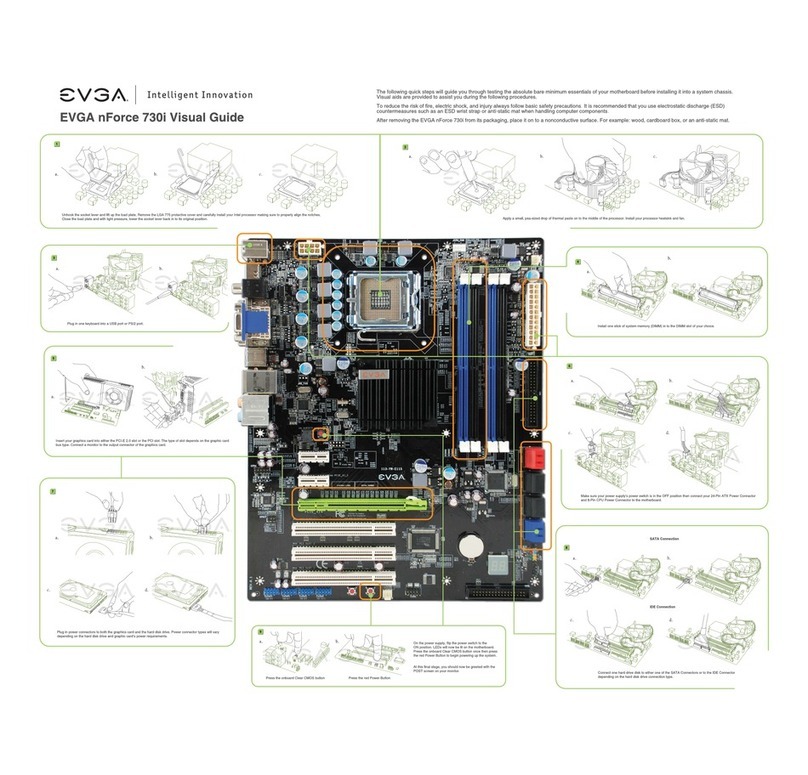
EVGA
EVGA 113-YW-E115-TR User manual
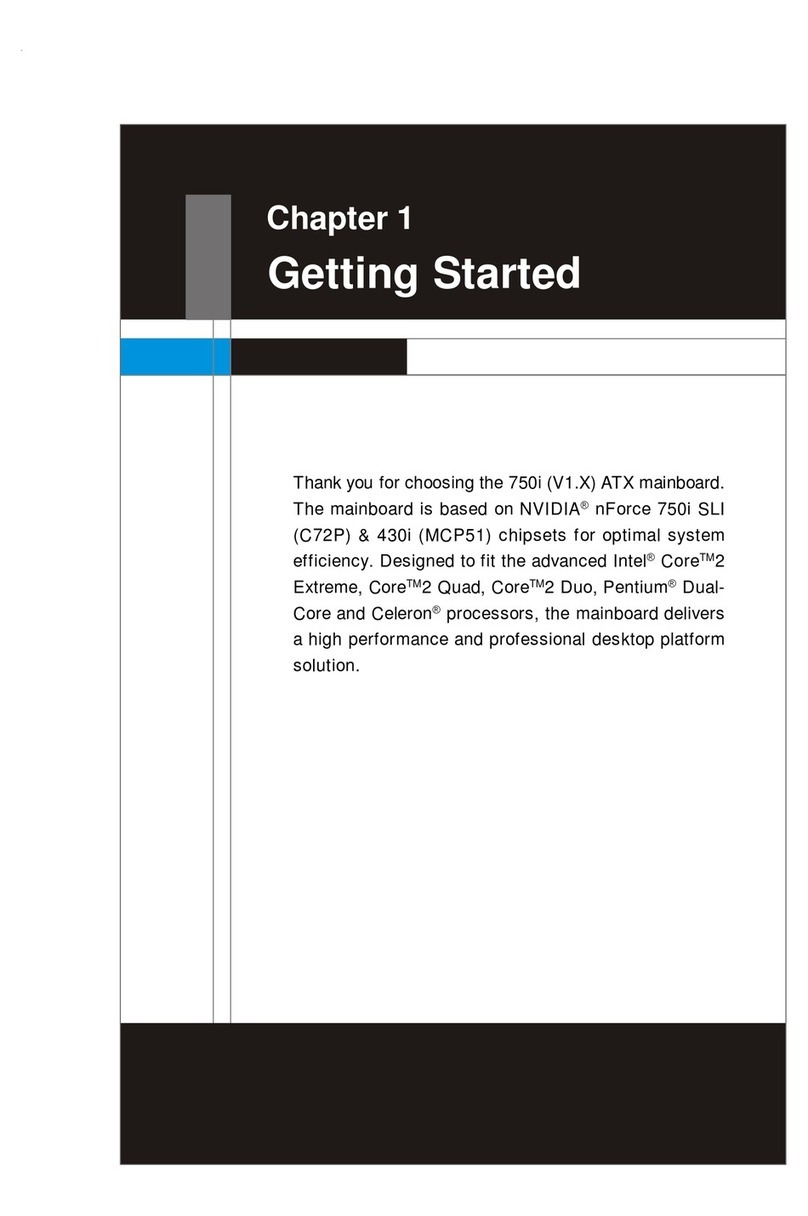
EVGA
EVGA nForce 750i SLI User manual

EVGA
EVGA Z68 FTW User manual

EVGA
EVGA H370 Stinger User manual
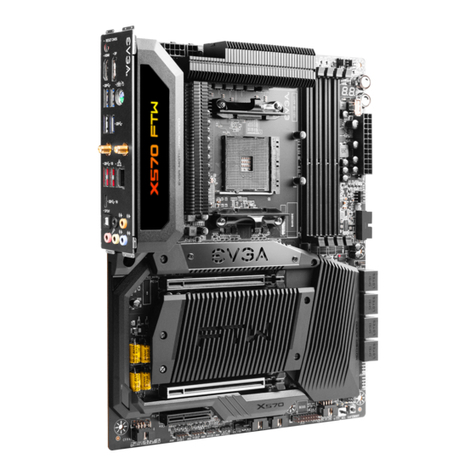
EVGA
EVGA X570 FTW Reference manual
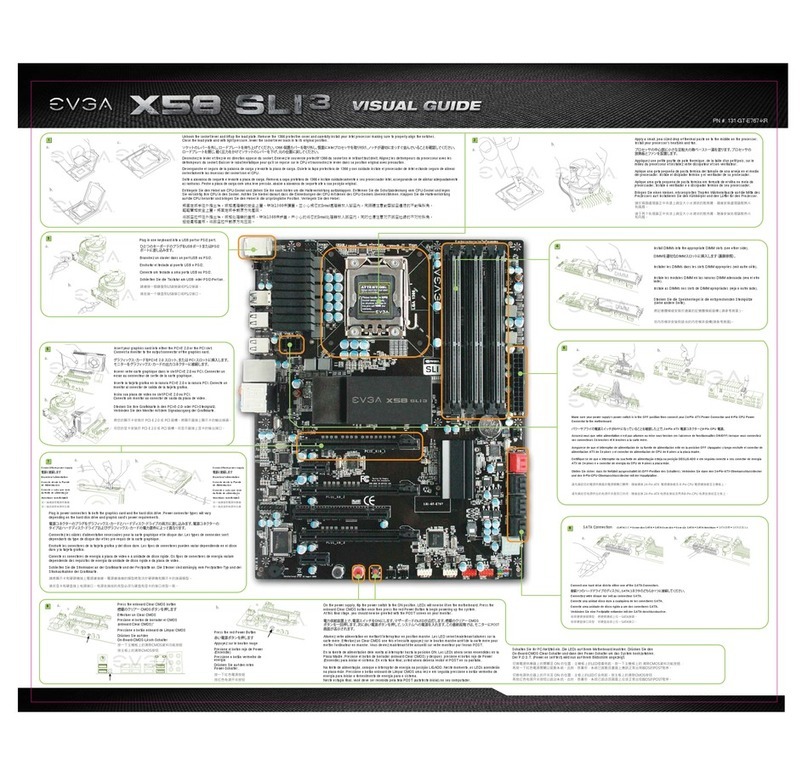
EVGA
EVGA 131-GT-E767-KR User manual
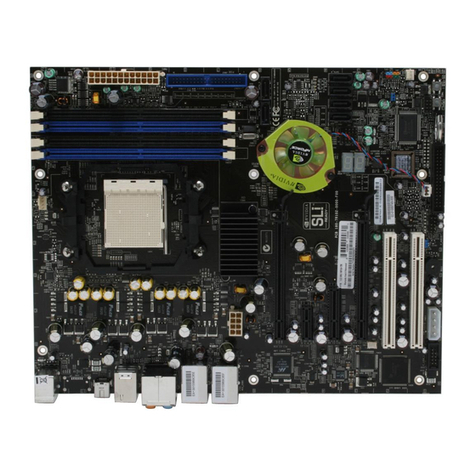
EVGA
EVGA 122-M2-NF59-TR User manual

EVGA
EVGA Z77 FTW User manual
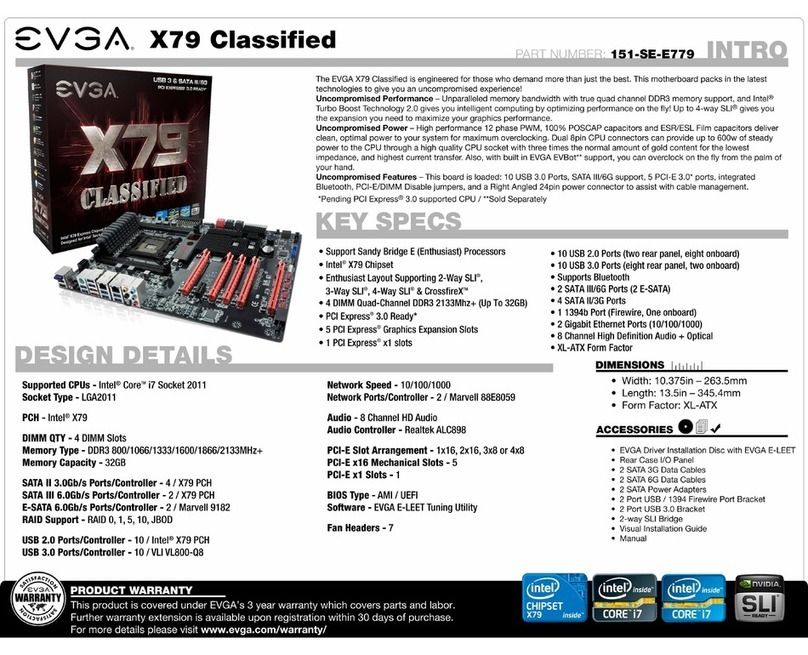
EVGA
EVGA X79 Classified User manual
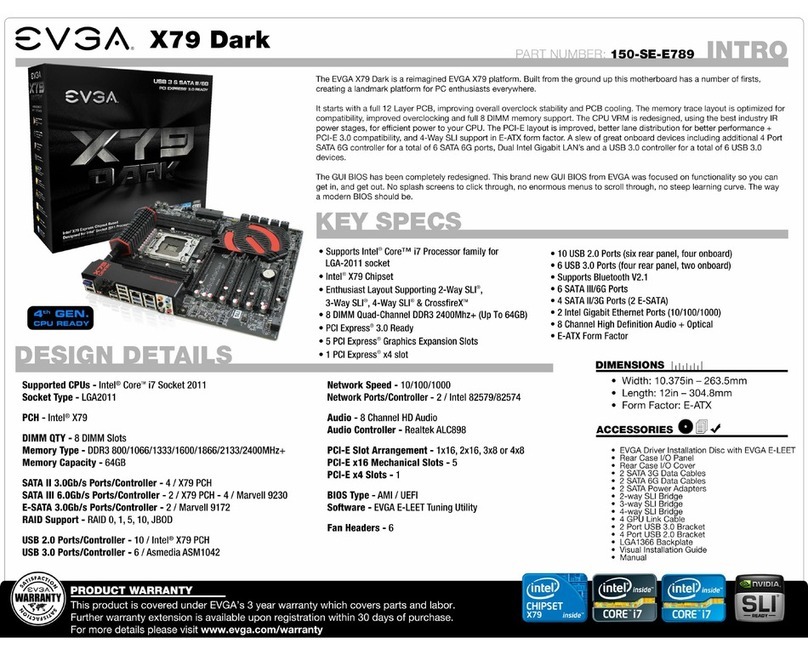
EVGA
EVGA EVGA X79 DARK System manual
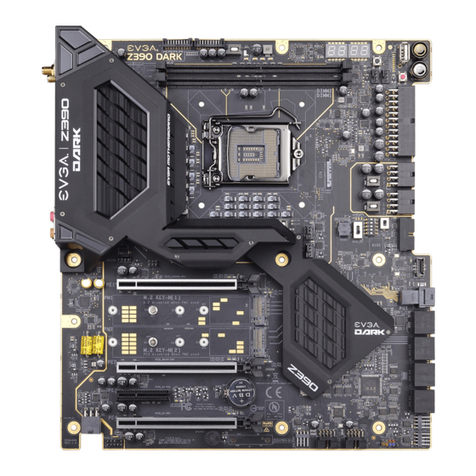
EVGA
EVGA Z390 DARK User manual
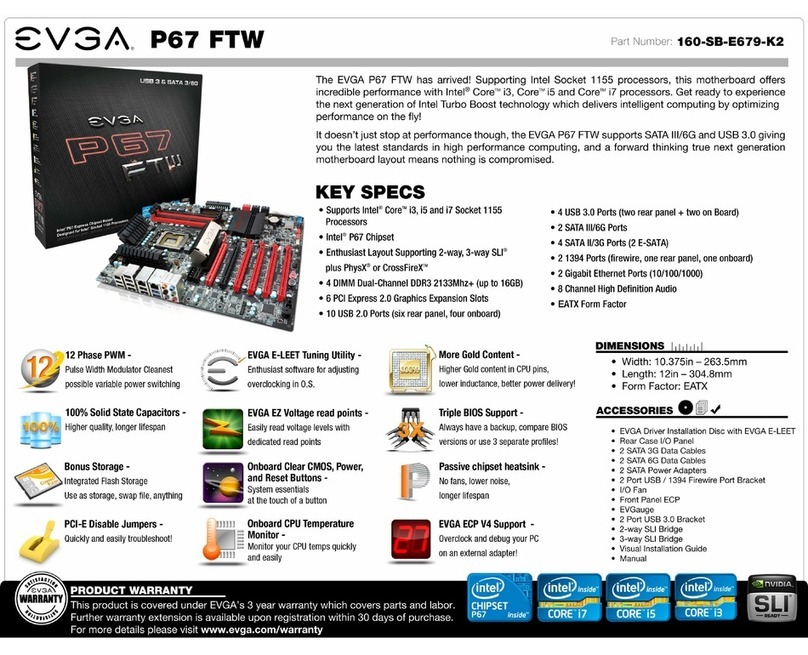
EVGA
EVGA P67 FTW Owner's manual
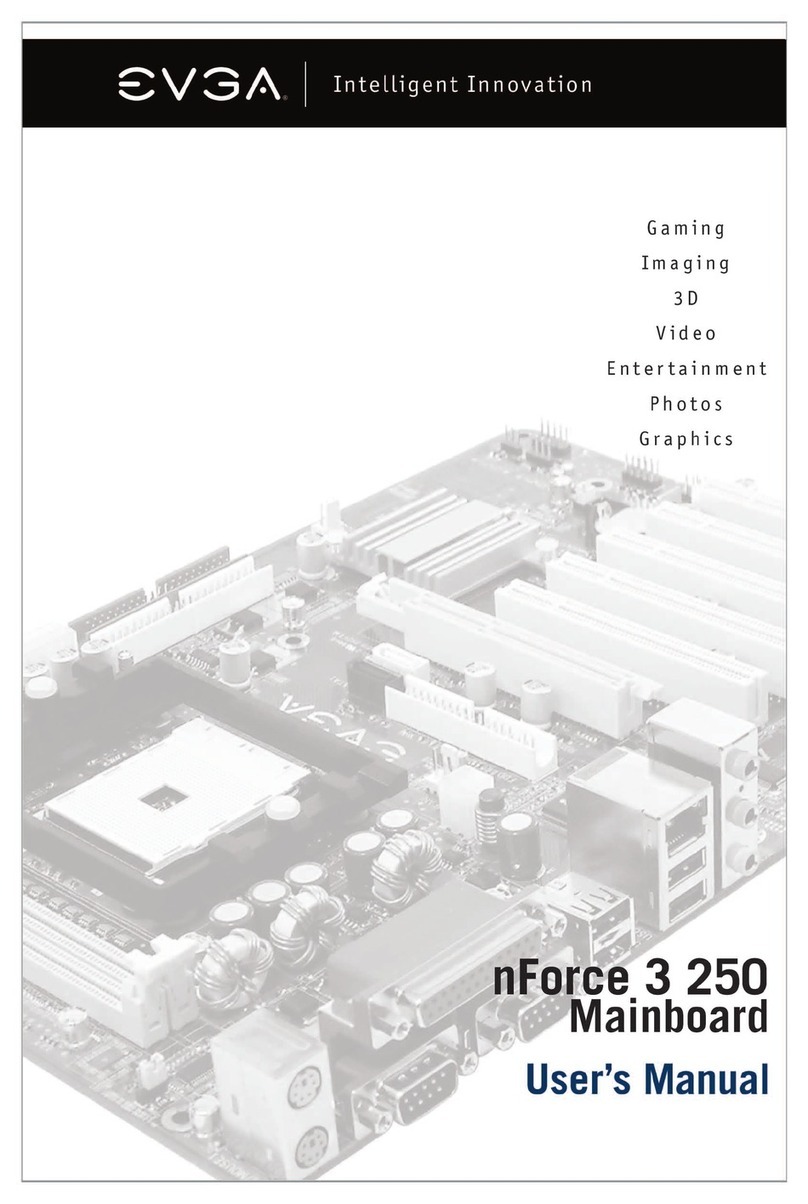
EVGA
EVGA nForce 3 250 User manual
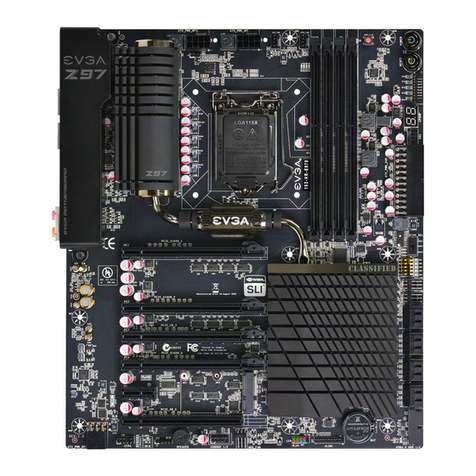
EVGA
EVGA Z97 User manual

EVGA
EVGA P55 Micro V User manual
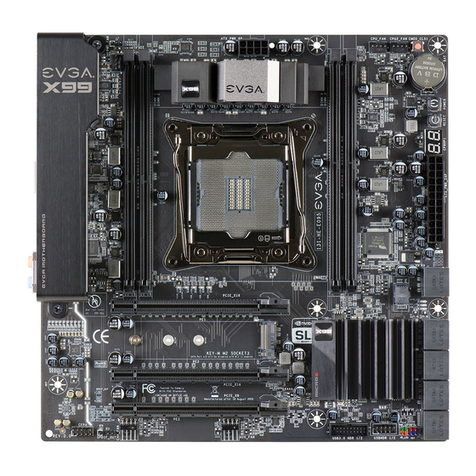
EVGA
EVGA X99 Micro2 User manual

EVGA
EVGA 130-SB-E685-KR User manual

EVGA
EVGA 120-LF-E650-TR User manual
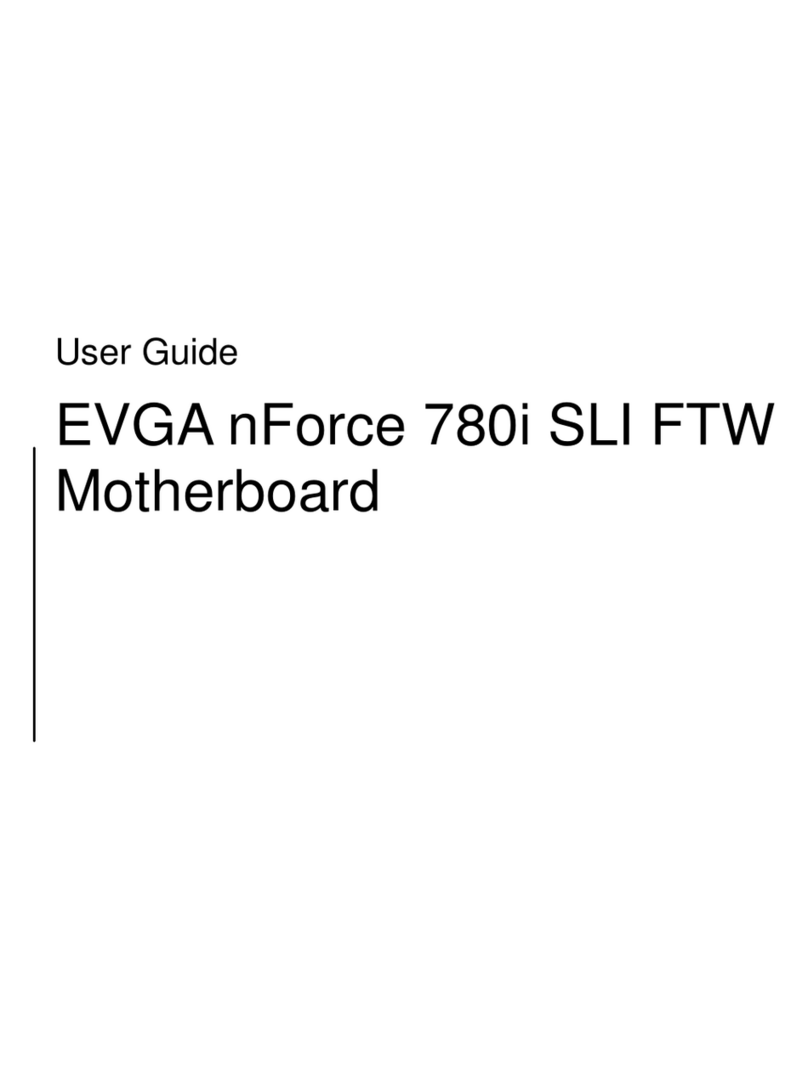
EVGA
EVGA nForce 780i SLI FTW User manual
